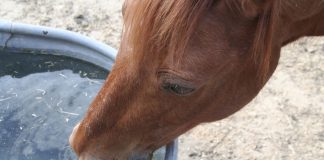There are a multitude of options available to ease the ache of equine arthritis—even more than there were just a few years ago. While there may be a plethora of prescription arthritis products available in your first-aid kit, there are many time-tested management methods that don’t include injections or medications to keep your horse comfortable.

What Is Arthritis?
Arthritis can occur anywhere in the equine body where two bones meet, including in the neck, back and legs. Horses with arthritic joints may have trouble moving, bending their necks to eat or moving from a lying to standing position.
Move It Or Lose It
While it’s important for your arthritic horse to stay as mobile as possible, it may seem counterintuitive to keep riding a stiff horse. You will need to back down your horse’s work load until it’s at a tolerable level for him. This may mean jumping lower heights (or eliminating it completely); reducing or eliminating time spent on intense movements such as sliding stops or rollbacks; or even limiting his under-saddle work to light walks around the farm.
Your arthritic horse may need a bit longer to warm up, but making sure his joints and muscles are warm and loose before beginning work will help prevent injuries and pain later on.
Very few horses need to be retired to the point where they are not ridden at all. Keeping your horse moving in a controlled, comfortable way is key to keeping his joints moving and maintaining muscle tone.
While it might be tempting to keep a painful horse up and stalled at times when they seem fairly stiff (like on days that are damp or cool), it really is best to turn him out as much as possible. As long as he isn’t turned out with herdmates that will run him ragged, your arthritic horse can meander at his own pace and do the things that are most comfortable to him.
Mealtime Maintenance
In the past, you may have fed your horse his grain from a pan on the floor and his hay from a pile in a corner of his stall, but it might now be painful for him to lower his head and neck to get a bite to eat. Keeping both hay and grain at chest height prevents him from having to lower his head all the way to the ground to eat.
Consider feeding hay from a hay rack or stringing up a haynet at a level that is more comfortable for your horse.
If your horse spends time in a stall or small corral, using extra bedding or putting down mats can help keep him more comfortable, especially if he tends to spend more time lying down to ease aching joints. Additional bedding can also help with traction if he struggles to get up because of sticky joints.

Alternative Therapies
Alternative therapies may be a worthwhile endeavor for both retired and active arthritic equines. Modalities such as massage and acupuncture can help keep seniors feeling their best. Massage in particular is well received by horses that may develop tighter muscles from the way they stand or travel because of arthritis. Completely non-invasive, massage is a relaxing technique that can help horses release tension they’re holding in their muscles.
The Hooves Have It
Proper hoof care is critically important for arthritic equines, whether they’re in work or not. Correct, regular trimming is essential for your horse’s comfort and ability to maintain pain-free movement.
If your horse was always shod during his active years, it might be tempting to pull his shoes and save money once he’s no longer in full work. However, it’s imperative that he remain as comfortable as possible to encourage movement. This might mean keeping him shod or possibly even in special shoes to alleviate any discomfort.
Footing First
While it’s always prudent to keep an eye on the footing where you’ll work your horse, it’s extra important for senior horses that may not have as much “give” in tendons and ligaments as younger horses. If you think the ring or trail may be too deep or too hard, it’s best to wait for another day to work him, rather than risk injury from unsafe footing.

The Weight Debate
Along with proper hoof care, keeping your arthritic horse at the proper weight is essential to keeping him comfortable into old age. Added weight means added stress on joints. While most people are concerned about an older horse becoming too skinny, the opposite is also a very real concern. You may need to adjust his feed as his caloric expenditure decreases upon partial or full retirement.
There are multiple management strategies that can be easily implemented in your routine to keep your arthritic equine going strong well into his golden years.
Liked this article? Here are others on arthritis in horses:
Ask the Vet: Preventing Joint Degeneration
Equine Arthritis






good info
I agree with this information, specially the weight control and hoof care.
Thank You I always find more good tips when I read these articles.
Has anyone tried the alcohol injections for treatment?
Great advice.